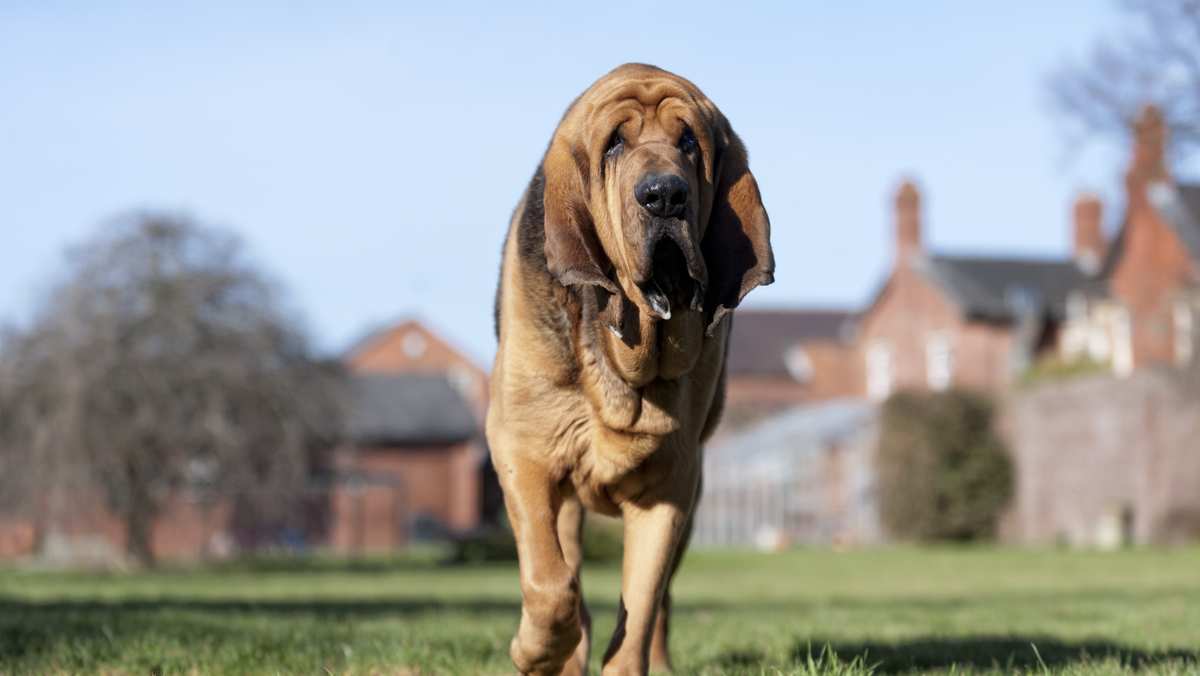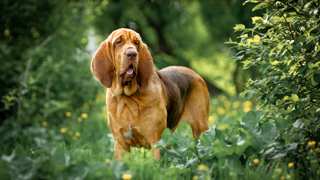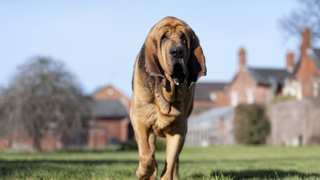Chien De Saint-Hubert
Flemish Hound
Saint Hubert Hound
Sleuth Hound
St. Hubert Hound
Famous for their wrinkled heads and droopy eyes, bloodhounds are renowned for their scent and tracking skills. Originally bred to trail wild boar, deer, and other large game, bloodhounds today more commonly use their scenting abilities to aid law enforcement.
Despite the breed's tracking ability, they are extremely friendly dogs to both people and animals. Their only desire in life is to follow a scent. They make good family dogs, however they can be difficult to care for so they are not recommended for people inexperienced with dogs.
The Bloodhound, a member of the Hound group of breeds, has been utilized as a scenthound and tracking dog for perhaps as long as recorded history itself. Dogs of this breed are affectionate, active, and intelligent, and are good both in a working capacity (particularly in tracking animals and/or people), and as a sensitive yet stubborn family pet.
Some facts about Bloodhounds: they're large-sized (height at the shoulders averages 25 inches, and weight 95 pounds), with short-haired, loose-skinned coats that come in various shades of brown and red. Here are some good (and not so good) qualities of this large, gentle breed:
PROS:
- Highly intelligent
- Affectionate and docile (except when tracking a scent!)
- Adaptable to both hot and cold climates
- Socializes well with kids and other pets
- Good watchdog abilities
- Moderately healthy
- Fantastic tracking skills
- Excels in agility trials and "doggy sports"
CONS:
- Can be stubborn
- Not good for apartment life
- High tendency to wander; will need to be leashed in public
- Drools a great deal
- High grooming/maintenance needs
- Frequent exercise required
- May be too large/active for households with small children
- Barks frequently (and loudly!)
Purebred
11 - 15 yrs.
23 - 27 in.
90 - 110 lbs
OverallFamily FriendlyChild FriendlyPet FriendlyStranger Friendly
Easy to GroomEnergy LevelExercise NeedsHealthShedding Amount
Barks / HowlsEasy to TrainGuard DogPlayfulnessWatch Dog
Apartment DogCan be AloneGood for Busy OwnersGood for New OwnersIntelligence
Bloodhound Breed Description
Bloodhounds can become fairly large dogs. Due to their body shape they are more often described as thick than tall and large. Male bloodhounds can get as tall as 27 inches from ground to shoulder and weigh over 110 pounds.
Bloodhounds are considered friendly dogs, although they can be a bit shy around people they're unfamiliar with. The breed can be stubborn and easily distracted, which can make them difficult to train. Bloodhounds are good with children and friendly with other pets. When excited the breed will bark (as part of their tracking instincts), so this may be a concern for those living close to their neighbors.
Once per week the bloodhound will need to be brushed and their wrinkles will need to be wiped with a damp cloth to prevent bacteria and dirt from collecting in the skin folds. The breed sheds seasonally so extra grooming will be required in the spring and fall. The breed has a lot of stamina and will need long walks daily to meet their exercise requirements.
Bloodhound history begins as far back as the first century A.D., when dogs of this type were known to track the scents of animals (and possibly people) for miles on end. This breed is believed to have descended from St. Hubert Hounds, bred chiefly by Belgian monks starting around 1,000 A.D.; in fact, in many French-speaking parts of the world the Bloodhound is referred to as the St. Hubert Hound even today. (The word "bloodhound," contrary to popular belief, does not refer to these dogs' ability to smell blood. According to fourteenth-century French writings, the name was given to describe a "hound of pure or noble blood.")
The earliest known reference to a Bloodhound as a distinct breed came in a French romance poem, translated to English in 1350, which described a Bloodhound that tracked a pair of runaway lovers through the countryside. During the ensuing centuries, the Bloodhound breed became known throughout Europe for its ability to track humans and animals alike. It is unclear exactly when these dogs first appeared in the United States, but it is known that Bloodhounds were used to track runaway slaves during the U.S. Civil War. In the years since, Bloodhounds have become valuable members of numerous U.S. law enforcement agencies, both as tracking and drug-sniffing dogs.
The American Kennel Club officially recognized the breed in 1885, and in 1952, breed enthusiasts formed the American Bloodhound Club. Today, these dogs are common worldwide; the breed ranks 52nd out of 202 breeds recognized by the AKC.
Overall, a Bloodhound is big, rangy, and thick-boned, with thin, loose skin that gives it a wrinkled appearance.
This breed's body is usually a bit greater in length than in height. The head and neck are covered with numerous loose wrinkles; the skull is in the shape of a narrow wedge. A Bloodhound's powerful nose sits in front of long, hanging jowls; the Bloodhound eyes, part of its signature deadpan expression, are heavy-lidded and often red-rimmed, and come in various shades of brown. The chest is narrow but deep, the shoulders muscular, the body long and cylindrical, and the legs straight, muscular, and heavy-boned. A Bloodhound's tail is long, sabre-like, and often curved.
The typical Bloodhound coat is short-haired and dense, and grows from extremely loose skin.
The images below represent the coat colors and patterns associated with Bloodhounds.
The Bloodhound is consistent in size, coat, and physical features, and sees little variation in those areas among individual dogs of the breed. Small Bloodhounds do exist, but are not typical. Some breeders offer Miniature Bloodhounds for sale, but those dogs, while indeed smaller, are not a known breed variation. Any Mini, Toy, or Teacup Bloodhound dog is likely a mixed breed, and is probably the result of unethical breeding practices.
The typical Bloodhound temperament is a Jekyll-and-Hyde situation: for a majority of the time, these dogs are sweet, gentle, and easygoing. But if set upon a scent trail, they become single-minded, stubborn, and even aggressive, as their single objective is following the scent. Overall Bloodhound behavior, though, sees them being affectionate, great with children, and sociable with other pets (particularly other dogs).
These erratic Bloodhound characteristics make training them, in a word, unpredictable. They're very intelligent, sensitive, and eager to please--but they can also be extremely stubborn, so teaching these dogs tasks or commands can be simple or difficult depending on the dog. Consistent, reward-based training methods are best. And according to professional trainers, if your Bloodhound's traits include stubbornness, keep the training sessions short if the dog acts disagreeable; forcing a Bloodhound to perform against its will is not recommended.
Bloodhounds make decent watchdogs (though their lack of aggression makes them poor guard dogs). Breed members will typically sound their loud, braying bark if confronted with a possible threat.
Bloodhounds as pets take special kinds of owners. While for the most part these dogs have agreeable personalities, they do bark--loudly!--quite a bit, and their coats need quite a bit of care. More precisely, the wrinkles in their loose skin are breeding grounds for infection, and will need to be checked (and cleaned with a damp cloth, if needed) 3-4 times per week.
Owning a Bloodhound will also require extra precautions when the dog is outdoors. With a high prey drive that includes an incredible sense of smell, a Bloodhound will instinctively follow any scent it finds interesting; these dogs will need well-secured yards, and they will definitely need to be leashed when in public areas.
And Bloodhounds are not hypoallergenic, so they may not be a good match for allergy sufferers. They shed moderately, but during the twice-yearly shedding seasons they shed a great deal, so owners will need to do a good bit of vacuuming.
Bloodhounds are fairly healthy overall, but do suffer from a few inherited health problems. These include hip and/or elbow dysplasia, bloat, hypothyroidism, epilepsy, and various eyelid/eyelash issues.
Life expectancy for these dogs is 11-15 years.
Bloodhound Health Concerns
Below are potential health concerns associated with Bloodhounds.
Bloat
Entropion
Hip dysplasia
Epilepsy
Hypothyroidism
Elbow dysplasia
Ectopic cilia
Ectropion
Some interesting facts about Bloodhounds:
- An unbelievable sense of small: Bloodhounds have about 230 million olfactory cells (also called "scent receptors") in their noses, which is at least 40 times the number in humans. Bloodhounds can track scents that are up to 300 hours old, and evidence obtained from Bloodhounds' searches is usually admissible in court cases; the Bloodhound is the only breed with that judicial recognition.
- Nathan the Bloodhound: A four-year-old Bloodhound named Nathan won Best in Show at the National Dog Show in Philadelphia; the win marked the first time a Bloodhound took the title at an AKC-sponsored event. Nathan's victory came shortly after the dog's heartbreaking loss at the Westminster Dog Show, when Nathan was upset in the final round by a Wire Fox Terrier named Sky.
- Bloodhounds are lazy? Hardly. A common belief is that Bloodhounds are lazy, and just lie around on the porch (an idea reinforced by TV shows like The Beverly Hillbillies, which featured a lazy Bloodhound named Duke). In reality, Bloodhounds are active, agile, and energetic--especially when they're tracking a scent.






